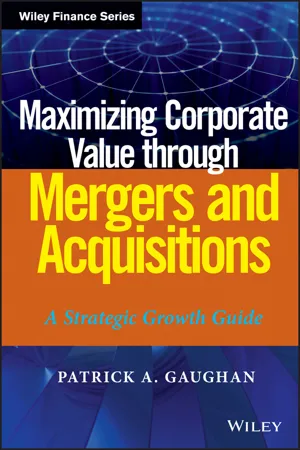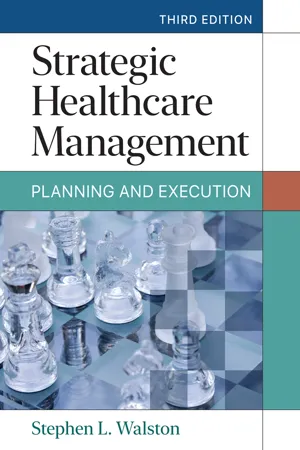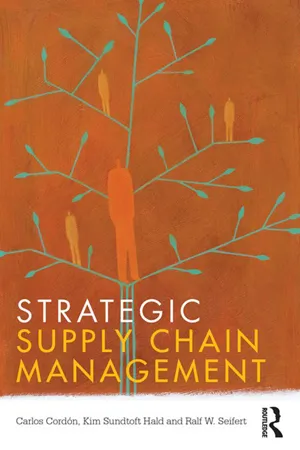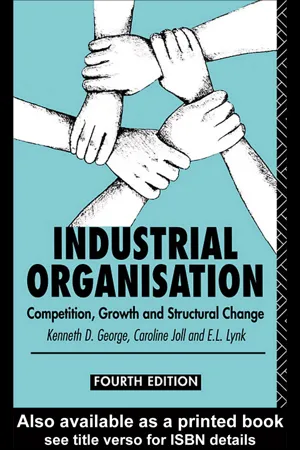Business
Vertical Vs Horizontal Integration
Vertical integration involves a company controlling different stages of the production process, such as manufacturing and distribution, while horizontal integration involves a company acquiring or merging with similar companies at the same stage of production. Vertical integration aims to streamline operations and reduce costs, while horizontal integration seeks to expand market share and eliminate competition.
Written by Perlego with AI-assistance
Related key terms
Related key terms
1 of 4
Related key terms
1 of 3
9 Key excerpts on "Vertical Vs Horizontal Integration"
- eBook - ePub
Maximizing Corporate Value through Mergers and Acquisitions
A Strategic Growth Guide
- Patrick A. Gaughan(Author)
- 2013(Publication Date)
- Wiley(Publisher)
CHAPTER 6 Vertical IntegrationWhile horizontal integration refers to combinations between competitors, vertical deals involve companies that have a buy-sell or upstream-downstream relationship. While they may not be as common as horizontal deals, there are still countless examples of vertical integration merger and acquisitions (M&A). The key question is what is the track record of such vertical deals? Unfortunately, too often it is questionable. In some instances and situations, it makes good sense for the companies involved. In these cases, vertical integration may be the best solution to a problem such as having a dependable source of supply. In other instances, it may fail to yield real benefits and result in a waste of corporate resources that could be better applied elsewhere.BENEFITS OF VERTICAL INTEGRATION
The benefits of vertical integration vary depending on the industry. When the deals involve, for example, a manufacturer buying a retailer, the deal may allow the manufacturer to gain better access to the ultimate consumers of their products. Similarly, in the petroleum industry, many of the larger companies have been vertically integrated for many years. It is common to see oil companies be involved, in exploration, transportation, and pipelines and refining, while also owning a large network of gas stations. When they are involved in all these areas, we say they are fully vertically integrated. Whether that is good or not is a debatable issue.RISK AND VERTICAL INTEGRATION
One of the benefits of being vertically integrated is that it can lower some of the risks a company faces in the marketplace. Buying a supplier can allow a company to have greater certainty in access to supplies. It may also allow these supplies to be more dependably available at more predictable prices. When getting access to key supplies is a major risk factor, companies may be able to lower this risk through vertical integration. By acquiring a supplier, they may be able to get a dependable source of inputs while possibly being able to gain a competitive advantage by preventing these supplies from being available to the competition. This competitive advantage may carry with it antitrust ramifications, but as markets have become increasingly globalized, most deals, especially vertical ones, tend to move through the antitrust approval process without a great deal of opposition. - eBook - ePub
Corporate Level Strategy
Theory and Applications
- Olivier Furrer(Author)
- 2016(Publication Date)
- Routledge(Publisher)
Chapter 10 Vertical Integration Coordinating the Value ChainDOI: 10.4324/9781315855578-10Vertical integration refers to the corporate level strategy by which a firm diversifies its activities along the industry value chain, whether by producing its own input (i.e., backward, or upstream, integration) or disposing of its own outputs (i.e., forward, or downstream, integration) (Grant, 2013 ; Harrigan, 1984 , 1985a ). Vertical integration increases a firm’s value added margins for a specific processing chain (Harrigan, 1985a) (see Figure 10.1 ) and thereby enjoys scale or integration economies, as well as greater control over sources of raw material or distribution outlets (Pfeffer & Salancik, 1978 ; Scherer & Ross, 1990 ).Figure 10.1 Stages in the industry value chainVertical integration, as a corporate level strategy, is often one of the first diversification strategies that firms embrace (Harrigan, 1984 ). Vertical integration can be assimilated to a corporate level strategy because it refers to the scope of a firm when it chooses to compete in particular value-adding stages of an industry value chain (Hofer & Schendel, 1978 ). Yet vertical integration also constitutes an internalization strategy (Williamson, 1975 ), in transaction cost theory terms, because the firm performs activities itself instead of relying on external suppliers or buyers.One of the famous examples of a fully vertically integrated firm is the Carnegie Steel Company during the late 1880s. At the height of its growth, the firm controlled not only the mills that manufactured the steel but also the mines from which the iron ore was extracted, the coal mines that supplied the coal, the ships that transported the iron ore to the factory, the railroads that transported the coal, the coke ovens that cooked the coal, and so on, along the entire value chain (Livesay, 1999 - eBook - ePub
- John Bridge, J. C. Dodds(Authors)
- 2018(Publication Date)
- Routledge(Publisher)
Vertical integration may occur backwards in which case the firm becomes engaged in operations previously undertaken by suppliers, for example, the manufacture of basic materials or components, or forwards, which involves the extension of operations towards the consumer, that is in distribution or retailing. The strategy offers limited opportunities for growth, but clearly there are only a finite number of operations between extraction of basic materials and sale of the final product. Vertical integration may offer greater security, a motive stressed by E.A.G. Robinson (136):Vertical integration is sometimes the consequence of a reuniting of separated processes of production. It is more often the consequence of a search for security. [p. 110]The security results from regularity of supply or the guarantee of a retail outlet, but, despite this kind of advantage, the firm’s dependence on a particular segment of economic demand leaves it sensitive to variations in the market and less able to respond to change. The same technology may run through several stages of the total operation, in which case the firm may benefit from synergy, but frequently the technology will differ (motor-vehicle manufacture and assembly involves an entirely different technology from the manufacture of electrical components for vehicles). Certainly a firm which enters retailing activities from a manufacturing base is unlikely to possess the managerial skills within its existing organisation, although typically this type of forward integration would be accomplished by taking over an existing concern. An associated disadvantage in connection with integration by acquisition is that the subsidiary may itself be diversified and consequently be engaged in types of production which have no natural relationship to the activities of the parent.Profit advantages may accrue through integration if the rates of return in the other stages of production are higher than in the original stage. There may also be cost savings which result from being able to avoid certain market transactions and associated selling costs. The assured supplies and orders which follow vertical integration also enable contingency stocks to be run down with a consequent release of working capital which can be re-invested profitably elsewhere in the business. It is not always true, however, that avoiding the market (for intermediate products) enables costs to be reduced, since administrative procedures do not necessarily provide a more efficient means of co-ordinating producer and user than the mechanism of the market. Furthermore, the effects which vertical integration may have on competition may be detrimental to the efficiency of the resource allocation process in the economy as a whole. - Stephen L. Walston(Author)
- 2023(Publication Date)
- AUPHA/HAP Book(Publisher)
chapter 5 , these structures enable organizations to enter a market more quickly with minimal risk. However, organizations in these arrangements have less control over their business outcomes, and alliances can be difficult to manage. As a result, problems arise and many of these structures dissolve. In the past, 85 percent of business leaders have felt alliances to be essential or important to their business. Yet failure rates exceeded 60 percent, and many alliances that avoid failure never realize their expected benefits (Whitler 2014; Sanders 2019). Organizations also risk losing important proprietary knowledge. When a network dissolves, Partner A can retain key technological information and perhaps even personnel from Partner B, potentially damaging Partner B’s competitive position.Vertical, Horizontal, and Diversified Expansion
Expansion also can occur vertically, horizontally, and through diversification. The literature often refers to vertical and horizontal expansion as vertical and horizontal integration. While in many cases the acquired organizations are not actually integrated , most of the benefits of these means of expansion accrue only if the organizations’ operations are integrated.Vertical expansion occurs when an organization acquires a business that is either a source of supplies (backward expansion) or an entity that may purchase from the organization (forward expansion). Thus, the organization buys stages of its industry value chain. For example, a paint manufacturer might own its own retail stores (e.g., Sherwin-Williams) or a hospital might employ physicians or own its own insurance company (e.g., a health maintenance organization [HMO], a preferred-provider organization).Horizontal expansion- Srinivas Reddy, Luca Pellegrini, Srinivas K. Reddy, Luca Pellegrini(Authors)
- 2012(Publication Date)
- Routledge(Publisher)
Vertical joint ventures are rare because the interests of adjacent members of a chain of supply are not so much complementary as directly competitive — where market access is the key resource, the retailer does not need alliances with (plentiful) manufacturing resource. Where technological prowess or manufacturing skills are more enduring, the proprietary nature of these skills can be protected without recourse to vertical control. However, asymmetric distribution of bargaining power can at least create potential for vertical control strategies where discontinuity of supply or market access is feared (notably across international boundaries).Vertical integration
Day (1984) suggests the advantages of vertical integration are better control and lower costs — the former by bringing the supplier closer to both the market and the consumer (a key element in current retailer success), and enabling tighter control of the brand, the latter usually by reducing or eliminating transaction costs when companies or functions are brought in-house. Similarly, Harrigan (1985) lists the principal competitive advantages of integration as:- improved marketing and technological intelligence;
- superior control of the firm’s economic environment
- product differentiation advantages.
In the context of supplier strategies, it is the control issues which are of particular importance. Just as retailers can use backward integration to secure sources of supply, so suppliers can use forward integration to control marketing and outlets. Profit Impact of Marketing Strategies (PIMS) data suggests that high vertical integration depresses profitability in the early stages of product/market evolution, but increases it in the later stages (Hofer and Schendel 1978 ). Porter (1980) provides an interesting explanation for this phenomenon: that early investments in vertical integration may be made at the expense of alternative production investments that would produce superior experience curve effects; however, later investments in vertical integration help the integrating firm to gain relative power in the value-added chain. The finding of Rumelt (1974)- eBook - ePub
- Carlos Cordón, Kim Sundtoft Hald, Ralf W. Seifert(Authors)
- 2013(Publication Date)
- Routledge(Publisher)
2.1 Effect on profitability of sales increase vs. supply chain improvementBase10% sales increase10% supply chain improvementSales ($) 100 110 100 Supply chain costs ($) 70 77 63 SG&A ($) 20 20 20 Profit ($) 10 13 17Vertically and horizontally integrated supply chains
The level of vertical integration is the degree of integration up and down a supply chain. For example, if a retailer starts manufacturing the products it sells, it is increasing its level of vertical integration. Vertical integration may be upstream or downstream. The interesting question is, how many consecutive steps in the supply chain should the company control and own? Two extremes are the Ford Motor Company in the 1920s and Lacoste today. Ford was known in the early 20th century for owning all of the supply chain tasks, from managing the plantations that produced rubber for the tires, to tire making, car assembly and delivery. By contrast, Lacoste is an almost fully outsourced company: manufacturing and distribution are entirely outsourced, while marketing and design are largely outsourced.The level of horizontal integration is the breadth of activities at the same point in the supply chain. A typical method of increasing the level of horizontal integration is to acquire other companies or brands in the same business. For example, supermarkets that are moving toward selling a larger variety of non-food items are increasing their level of horizontal integration. Another example is Volkswagen’s efforts to merge with Porsche: by merging with another brand in the same field, Volkswagen was able to consolidate its activities and thereby achieve economies of scale.Although in the last century we have seen many companies pursue a much lower level of vertical integration, this evolution does not mean that companies must strive for vertical disintegration. If anything, today there are extremely successful corporations like Inditex (the owner of the Zara fashion chain) and Luxottica (the world leader in eyewear) that have a high level of vertical integration, but there are also thriving companies like Hewlett-Packard that have a very low level of vertical integration. Thus, it cannot be said that a high or low level of vertical integration on its own is the key to success. The main advantages and drivers of vertical integration of supply chain flows are: - George J. Staubus(Author)
- 2021(Publication Date)
- Routledge(Publisher)
Expansion strategy is addressed first. Aside from simple increase in the volume of given activities, firms typically consider “upstream,” or backward integration, or “downstream,” or forward integration, and/or they consider “horizontal” diversification of products sold. The two historically dominant forms of organization have been called “functional” and “multidivisional,” or M-form. The influence of these organization forms on accounting is addressed in the third section of the chapter. One might observe that all of the prominent firms in an economy are large, vertically integrated, and diversified. That makes separating the influences difficult. A good place to start is with a clear understanding of the underlying economic phenomena, especially vertical integration.VERTICAL INTEGRATION
An integrated firm performs more than one activity, each of which is related to another or others by an output-input linkage. To integrate vertically means to extend the sequence of activities within a firm, either by adding an activity previously performed by a supplier (making instead of buying a good used in the firm) – backward integration – or by adding an activity previously performed by a customer of the firm – forward integration. A state of integration exists when separable activities, such as mixing dough, baking, slicing and wrapping bread all occur in the same firm.Certain integrations of activities, such as those just mentioned, are common and may, therefore, seem natural. James Thompson called such a set of activities “core technology” (1967, p. 19 ). Others, such as inclusion of wheat growing, flour milling, selling bread at retail, sandwich making, and sandwich retailing in a firm that mixes, bakes, slices and wraps bread, are less common. Lack of a market for the intermediate product, e.g., mixed, unbaked dough, suggests that adjacent activities commonly are integrated. Large firms that are not highly integrated are scarce or nonexistent. Practically speaking, all firms are integrated firms.Now consider any two adjacent activities mentioned in the preceding two paragraphs, such as mixing bread dough and baking bread. It is possible to organize the related activities by administrative direction within one firm, and it is possible to organize them in two firms related by market transactions. Certain pairs of the above activities commonly are organized within one firm; others commonly are organized across markets. Why? According to Coase, “a firm will tend to expand until the costs of organizing an extra transaction within the firm become equal to the costs of carrying out the same transaction by means of an exchange on the open market or the costs of organizing in another firm.” (1937, p. 395) This is a “transaction cost economics” answer to the integration question. Williamson has a broader explanation: “Holding the nature of the good or service to be delivered constant, economizing takes place with reference to the sum of production and transaction costs, whence trade-offs in this respect must be recognized.” (1985, p. 22- Chris Rowley, Malcolm Warner(Authors)
- 2013(Publication Date)
- Routledge(Publisher)
Harrigan (1986: 535) states that firms face a host of structural decisions about whether to adopt full integration, tapered integration or quasi-integration. She investigates 192 firms that operate in diverse strategic environments to ascertain how the successful deployment of vertical integration differs from less successful deployments, and concludes that the vertical integration of corporate management is influenced by factors such as industry structure and evolution, competitive posture and the strategic position of the firm. Previous studies have examined whether the definition of vertical firm-specific resource boundaries is intimately associated with the development structure in which a firm’s asset specificities are embedded and the means through which the firm accesses and influences managers who are controlled by the local organizational infrastructures (Marchington and Vincent, 2004; Mota and De Castro, 2004). Studies of the effects of vertical integration on corporate management concentrate on one of three areas. The first is strategic orientation, which is increasingly employed to guide businesses, as it provides a method for planning the coordination of a firm’s business development activities. The drive to achieve a strategic orientation can act as trigger for an organization to accomplish its missions and goals (Grewal and Tansuhai, 2001). More specifically, a firm’s strategic orientation for the achievement of long-term business development is closely related to the assessment of the business environment, the recognition of corporate culture and an emphasis on performance evaluation (Maxwell et al., 2004). The second area is contractual control, which is seen as pivotal to ensuring that service qualities are well managed. Contractual power over a firm’s asset specificities mainly serves to mobilize, allocate and leverage resources and capabilities- eBook - ePub
Industrial Organization
Competition, Growth and Structural Change
- Kenneth George, Caroline Joll, E L Lynk(Authors)
- 2005(Publication Date)
- Routledge(Publisher)
Chapter 7 . Here we note that the more important are customer attachments and the emphasis on continuity, the lower will be the costs of using the market. In Okun’s own development of the customer attachments model the illustrations are taken in the main from the retailing and hotel trades. However it may well be that his ideas are more relevant in analysing inter-firm relationships in the market for intermediate goods.The forces shaping the extent and pattern of vertical relationships are complex and it should not be a surprise to find differences in the degree of integration even between firms in the same general field of activity. This may be due for instance to differences in managerial ability to coordinate the different stages of production and distribution. Or it may be due to the different experiences which firms have had with suppliers and thus different perceptions about the transactions costs of using the market. The fact that one firm is more highly integrated than another may also reflect differences in profitability and in the finance available for integration, or it may reflect a different view about future supply and demand conditions. In determining future strategy, some firms will see vertical integration as the most profitable use of funds, others will choose to extend their production horizontally in existing markets or to diversify into new areas of activity.3.3 DIVERSIFICATION
Diversification involves the addition to the firm’s activities of other products or services that are not vertically related to existing ones. The distinction between diversification and horizontal expansion in existing lines may appear to be self-evident, but it is in fact blurred because of the widespread practice of product differentiation (i.e. the production by a firm of different varieties of the ‘same’ product). In many instances it may be difficult in practice to draw a sharp distinction between product differentiation and product diversification. Quite apart from this problem, the degree of diversification itself can vary substantially. In terms of the Census of Production classification (see Chapter 5
Index pages curate the most relevant extracts from our library of academic textbooks. They’ve been created using an in-house natural language model (NLM), each adding context and meaning to key research topics.
Explore more topic indexes
Explore more topic indexes
1 of 6
Explore more topic indexes
1 of 4








